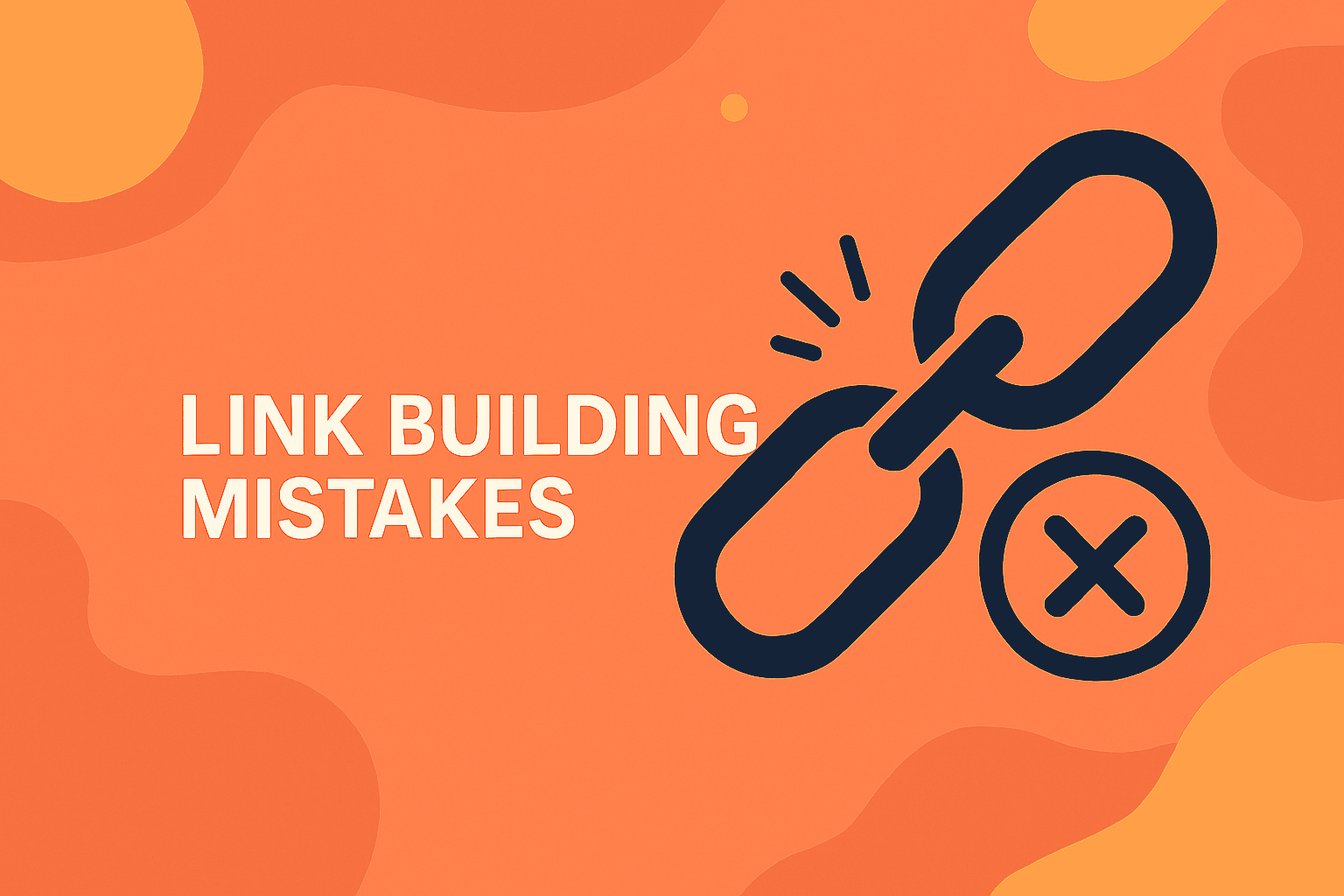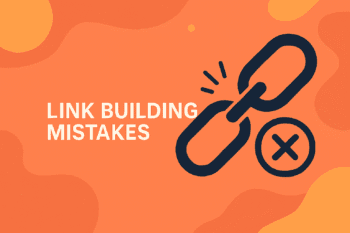If your rankings aren’t improving, you might be making a few link building mistakes without realizing it. You’ve sent outreach emails, secured backlinks, maybe even paid for a few “high-DR” spots – yet the needle barely moves.
Here’s the kicker: most people mix up link building with backlinks. One is the effort you put in, the other is the result you earn. Link building still works in 2025, but sloppy tactics and lazy shortcuts can quietly tank your SEO faster than doing nothing at all.
Once you understand what to watch for, these mistakes become easy to catch and even easier to correct.
Key Takeaways
- Link building isn’t dead in 2025 — but poor-quality backlinks can drag your site down fast.
- It’s not about stacking links anymore. Aim for relevant, trustworthy ones that actually carry weight.
- Avoid shortcuts. PBNs, link farms, and stuffed anchors will hurt you more than they’ll help.
- Vary your links. Different types and sources help your profile stay natural and balanced.
- Keep tabs on your backlinks. Run audits, remove the junk, and protect your domain health.
- Link building works a lot like relationships. The real results come from being consistent, not chasing quick wins.
Mistake #1: Building links without relevance or authority
The most common mistake? Saying yes to any backlink opportunity that comes your way.
Getting a link from a site that has nothing to do with your niche might look good on paper, but it sends mixed signals to Google. Real, quality link building isn’t about chasing every backlink you can find. It’s about earning contextually relevant links from trusted sites that actually make sense for your niche. Those kinds of backlinks strengthen your authority instead of confusing Google about what your site’s about. That’s the kind of context that builds authority and trust.
Fix it:
Target sites within your niche or closely related verticals. For SaaS companies, a single guest post on a credible tech or productivity blog is far more valuable than a pile of unrelated lifestyle links. Before you pitch, pop those sites into Ahrefs or Semrush to see if their traffic and topics actually line up with yours.
Mistake #2: Treating quantity as quality
Old SEO thinking: “More links = higher rankings.”
Modern SEO reality: “Better links = safer, stronger rankings.”
Google’s algorithm now looks beyond link counts. It measures how relevant, trusted, and contextually placed those links are. A handful of backlinks from respected niche publications or partners can do more than hundreds of random mentions on weak sites.
Think of it like recommendations — one from an industry expert carries more weight than 20 from people no one knows.
The smartest backlink strategy isn’t about numbers. Focus on earning a few solid links that actually count. Look at which pages already perform well, see where your competitors are getting mentioned, and go after similar spots.
Fix it:
Go after backlinks that actually matter, such as features in articles, real partnerships, or solid PR mentions. Link building works best when it’s built on trust, not transactions.
Mistake #3: Over-optimizing anchor text
Loading every backlink with the same keyword might feel like a smart move, but it’s exactly what sets off Google’s spam alarms.
When every link to your “best SEO tools for small biz” article uses that exact phrase, Google sees it as manipulation—not relevance. Natural anchor text signals that your links were earned, not forced.
A strong backlink profile mixes branded, partial-match, and generic anchors. Use phrases like “check out this guide,” “from WebJuiceMedia,” or “this list of SEO tools.” It reads better for users and looks far more organic to search engines.
Fix it:
Mix it up. Use branded anchors (“Nike guide”), partial matches (“top shoes for runners”), or even natural phrases (“check out this review”). Aim for 70–80% natural anchors and let your content contextually reinforce the keyword.
Mistake #4: Ignoring link diversity
When too many of your backlinks come from similar sources, such as guest posts or directories, it can make your profile look off balance. Depending only on profile link building or one method limits your reach. Try different backlink’s building techniques to keep your profile varied and natural.
Google expects a healthy mix: follow and nofollow links, contextual and image links, new and old referring domains.
Fix it:
Mix up your backlink game. Blend digital PR, HARO opportunities, partnerships, resource mentions, and the occasional high-quality guest post. A healthy mix keeps your link profile looking natural and strong. Natural variety signals authenticity.
Mistake #5: Buying links or using PBNs
Buying cheap backlinks might seem like a shortcut—right up until your rankings fall off a cliff. PBNs and link farms leave digital fingerprints that Google spots a mile away. Google’s SpamBrain update specifically hunts these down. The safer approach is white hat link building, where links are earned through genuine relationships, high-quality content, and brand authority – not paid schemes or shady networks. It takes longer, but it’s the kind of strategy that keeps your rankings stable and your reputation clean.
Fix it:
If a vendor guarantees placements or sells 100 “DR 80+” links for $99, run.
Invest in legitimate outreach or PR. Build content worth linking to, like data studies, guides, or interactive tools. Real authority takes time – but it sticks.
Mistake #6: Neglecting internal linking
Backlinks usually steal the spotlight, but it’s your internal links doing the real work. They quietly pass authority – or what SEOs often call “link juice” – between pages, helping Google understand your site, and keeping visitors exploring longer.
Think of internal links as a map for both users and search engines. They show which pages matter most and how everything ties together behind the scenes. Linking from newer blog posts to cornerstone guides strengthens those key pages over time.
If you want a quick win, audit your top-performing posts and add links to related resources or service pages. It’s one of the simplest SEO linkbuilding tips that boosts both rankings and user experience – and you don’t even need new content to do it.
Fix it:
Map your most important pages and connect them logically. Use descriptive anchors, link from new blog posts to older resources, and ensure no orphan pages. Internal linking is free, fast, and one of the most underrated SEO linkbuilding tips out there.
Mistake #7: Forgetting to audit your backlink profile
Old backlinks don’t age like wine. Over time, some of them turn toxic — especially if you’ve bought links, joined link swaps, or tried those “100 backlinks for $50” deals. When those sites get deindexed or flagged as spam, your domain can quietly take the hit too.
A healthy backlink profile isn’t a “set and forget” thing. It’s worth checking your backlinks every so often to catch any that have gone bad or lost relevance. Tools like Ahrefs, Semrush, and Google Search Console make it easy to see who’s linking to you — and whether those links are actually doing you any good.
Set a schedule to audit quarterly and clean up as needed. It’s like spring cleaning for your SEO—boring but powerful.
Fix it:
Run quarterly backlink audits. Tools like Ahrefs, Google Search Console, or the Google Disavow Tool can help you spot risky domains. Don’t nuke your entire backlink profile—only disavow the links that obviously break Google’s rules.
Mistake #8: Ignoring content alignment
Links only work when they make sense in context. If your backlink sits inside a paragraph that has nothing to do with your topic, Google devalues it — and readers ignore it too.
Search engines now analyze the surrounding text to gauge how relevant a link really is. That’s where editorial seo comes in – thoughtful, topic-focused writing that naturally supports your links. When your content flows logically and offers genuine insight, backlinks feel earned, not inserted.
If you’re adding a link to a post on content writing for small business, place it within content about marketing or copywriting — not in a generic business roundup. Strong context and editorial quality makes a link far more valuable to Google.
Fix it:
Before you drop a link into any article, step back and read the paragraph it’s going in. Does it actually add context or just fill space? If the answer’s the latter, rewrite the section so the link feels like part of the story, not an afterthought. A well-placed backlink should help the reader understand the topic better – that’s how Google knows it belongs there.
Mistake #9: Failing to build relationships
SEO isn’t a solo sport. Those cold, copy-paste emails that start with “Hey {name}, can I guest post on your site?” rarely get a reply. Real backlinks come from trust, not templates.
The best links come from people who know your work and respect your expertise. Start by joining conversations, sharing others’ content, or collaborating on something valuable. As your network grows, so do your opportunities — especially if you’re exploring building links internationally and want to connect with publishers in different markets.
When outreach feels like genuine networking, people notice. Over time, those connections turn into guest posts, mentions, and steady referral traffic that Google actually values.
Fix it:
Start by being part of the community. Comment on posts, share valuable content, or team up on a project. When your outreach feels authentic, and not transactional, people are far more open to saying yes.
Mistake #10: Treating link building as a one-off project
Link building isn’t a campaign; it’s a system. Many brands run one “backlink sprint,” then ignore it for months while competitors quietly keep building. SEO doesn’t freeze — if you’re not earning new links, you’re falling behind.
Make link building part of your routine. Update content that still attracts backlinks, schedule monthly outreach, and look for partnerships that create steady visibility. That consistency is what keeps your rankings growing.
Fix it:
Plan regular link-building cycles: outreach each month, audits every few months. Publish content that earns attention – data studies, resources, or tools. For ecommerce, focus on practical content like detailed product guides, helpful buying resources, and smart brand partnerships. They’re the kind of assets that naturally earn consistent links over time.
Are links still important to SEO in 2025?
Short answer: yes – but context matters more than ever.
Under Google’s EEAT framework, links remain one of the strongest signals of a site’s trust and authority. But the right kind of links: relevant, earned, and supported by credible content.
A single editorial link from a trusted industry site outweighs hundreds of irrelevant backlinks.
So while the volume game is fading, link equity is still one of the clearest trust signals in Google’s algorithm.
TL;DR – Quick Recap
| Mistake | Why It Hurts | Quick Fix |
|---|---|---|
| Building irrelevant links | Confuses Google about your niche | Target niche-relevant domains |
| Focusing on quantity | Creates spam signals | Prioritize authority and relevance |
| Over-optimized anchors | Triggers link spam filters | Use branded and natural anchors |
| One-dimensional link sources | Looks manipulative | Mix formats and link types |
| Buying links / PBNs | Risk of penalties | Earn editorial or PR-based links |
| Ignoring internal links | Wastes link equity | Build smart internal structures |
| No backlink audits | Toxic links drag rankings | Review and disavow quarterly |
| Poor content alignment | Weakens context | Place links in topic-relevant text |
| No relationship building | Low outreach success | Network and personalize outreach |
| Treating link building as one-off | Loses momentum | Maintain consistent link growth |
Final Thoughts
Bad backlinks can sneak up on you. They sit quietly in the background, chipping away at your rankings bit by bit. If you’ve spotted a few, take a breath. Check your backlink profile and remove the links that slow you down. Build stronger ones with sites that actually fit your niche. Be patient and keep at it. Consistency is what keeps your SEO strong over time.
If you’re wondering what “good” links really look like, start with your own network. Build connections with sites that actually make sense for your brand. SEO these days runs on trust and relevance, not hacks. Play the long game, and your links will eventually pull their own weight.





